Investigation of Monolithic 3D Integrated Circuit Inverter with Feedback Field Effect Transistors Using TCAD Simulation
Abstract
1. Introduction
2. Simulation Structure Parameters
3. Simulation Results
3.1. Memory Window
3.2. Voltage Transfer Characteristics
3.3. Transient Response
4. Conclusions
Author Contributions
Funding
Acknowledgments
Conflicts of Interest
References
- Waldrop, M.M. The chips are down for Moore’s law. Nature 2016, 530, 144–147. [Google Scholar] [CrossRef] [PubMed]
- Kuhn, K.J.; Giles, M.D.; Becher, D.; Kolar, P.; Kornfeld, A.; Kotlyar, R.; Ma, S.T.; Maheshwari, A.; Mudanai, S. Process Technology Variation. IEEE Trans. Electron Devices 2011, 58, 2197–2208. [Google Scholar] [CrossRef]
- Chen, T. Overcoming research challenges for CMOS scaling: Industry directions. In Proceedings of the 2006 8th International Conference on Solid-State and Integrated Circuit Technology Proceedings, Shanghai, China, 23–26 October 2006; pp. 4–7. [Google Scholar] [CrossRef]
- Claverlier, L.; Deguet, C.; Di Cioccio, L.; Augendre, E.; Brugere, A.; Gueguen, P.; Le Tiec, Y.; Moriceau, H.; Rabarot, M.; Signamarcheix, T.; et al. Engineered substrates for future More Moore and More than Moore integrated devices. In Proceedings of the 2010 IEEE International Electron Devices Meeting (IEDM), San Francisco, CA, USA, 6–8 December 2010; pp. 2.6.1–2.6.4. [Google Scholar] [CrossRef]
- Black, B.; Annavaram, M.; Brekelbaum, N.; Devale, J.; Jiang, L.; Loh, G.H.; McCaule, D.; Morrow, P.; Nelson, W.; Pantuso, D.; et al. Die Stacking (3D) Microarchitecture. In Proceedings of the 2006 39th Annual IEEE/ACM International Symposium on Microarchitecture (MICRO’06), Orlando, FL, USA, 9–13 December 2006; pp. 469–479. [Google Scholar] [CrossRef]
- Davis, W.R.; Wilson, J.; Mick, S.; Xu, J.; Hua, H.; Mineo, C.; Sule, A.M.; Steer, M.; Franzon, P.D. Demystifying 3D ICs: The pros and cons of going vertical. IEEE Des. Test Comp. 2005, 22, 498–510. [Google Scholar] [CrossRef]
- Knickerbocker, J.U.; Andry, P.S.; Dang, B.; Horton, R.R.; Interrante, M.J.; Patel, C.S.; Polastre, R.J.; Sakuma, K.; Sirdeshmukh, R.; Sprogis, E.J.; et al. Three-dimensional silicon integration. IBM J. Res. Dev. 2008, 52, 553–569. [Google Scholar] [CrossRef]
- Vinet, M.; Batude, P.; Tabone, C.; Previtali, B.; LeRoyer, C.; Pouydebasque, A.; Clavelier, L.; Valentian, A.; Thomas, O.; Michaud, S.; et al. 3D monolithic integration: Technological challenges and electrical results. MicroElectron Eng. 2011, 88, 331–335. [Google Scholar] [CrossRef]
- Cheramy, S.; Jouve, A.; Arnaud, L.; Fenouillet-Beranger, C.; Batude, P.; Vinet, M. Towards high density 3D interconnections. In Proceedings of the 2016 IEEE International 3D Systems Integration Conference (3DIC), San Francisco, CA, USA, 8–11 November 2016; pp. 1–5. [Google Scholar] [CrossRef]
- Wong, S.; El-Gamal, A.; Griffin, P.; Nishi, Y.; Pease, F.; Plummer, J. Monolithic 3D integrated circuits. In Proceedings of the 2007 International Symposium on VLSI Technology, Systems and Applications (VLSI-TSA), Hsinchu, Taiwan, 23–25 April 2007; pp. 1–4. [Google Scholar] [CrossRef]
- Panth, S.; Samal, S.; Yu, Y.S.; Lim, S.K. Design challenges and solutions for ultra-high-density monolithic 3D ICs. In Proceedings of the 2014 SOI-3D-Subthreshold Microelectronics Technology Unified Conference (S3S), Millbrae, CA, USA, 6–9 October 2014; pp. 1–2. [Google Scholar] [CrossRef]
- Yu, Y.S.; Panth, S.; Lim, S.K. Electrical coupling of monolithic 3-D inverters. IEEE Trans. Electron Devices 2016, 63, 3346–3349. [Google Scholar] [CrossRef]
- Koneru, A.; Chakrabarty, K. Analysis of electrostatic coupling in monolithic 3D integrated circuits and its impact on delay testing. In Proceedings of the 2016 21st IEEE European Test Symposium (ETS), Amsterdam, The Netherlands, 25 July 2016; pp. 1–6. [Google Scholar] [CrossRef]
- Fan, M.; Hu, V.P.; Chen, Y.; Su, P.; Chuang, C. Investigation and optimization of monolithic 3D logic circuits and SRAM cells considering interlayer coupling. In Proceedings of the 2014 IEEE International Symposium on Circuits and Systems (ISCAS), Melbourne, Australia, 1–5 June 2014; pp. 1130–1133. [Google Scholar] [CrossRef]
- Lim, S.K. Bringing 3D ICs to Aerospace: Needs for Design Tools and Methodologies. J. Inf. Commun. Converg. Eng. 2017, 15, 117–122. [Google Scholar] [CrossRef]
- Sideris, P.; Brunet, L.; Sicard, G.; Batude, P.; Theodorou, C. Impact of Inter-Tier Coupling on Static and Noise Performance in 3D Sequential Integration Technology. In Proceedings of the 2019 Joint International EUROSOI Workshop and International Conference on Ultimate Integration on Silicon (EUROSOI-ULIS), Grenoble, France, 1–3 April 2019; pp. 1–4. [Google Scholar] [CrossRef]
- Sekar, D.C.; Or-Bach, Z. Monolithic 3D-ICs with single crystal silicon layers. In Proceedings of the 2011 IEEE International 3D Systems Integration Conference (3DIC), 2011 IEEE International, Osaka, Japan, 31 January–2 February 2012; pp. 1–2. [Google Scholar] [CrossRef]
- Jiang, J.; Parto, K.; Cao, W.; Banerjee, K. Monolithic-3D Integration with 2D Materials: Toward Ultimate Vertically-Scaled 3D-ICs. In Proceedings of the 2018 IEEE SOI-3D-Subthreshold Microelectronics Technology Unified Conference (S3S), Burlingame, CA, USA, 15–18 October 2018; pp. 1–3. [Google Scholar] [CrossRef]
- Shulaker, M.M.; Wu, T.F.; Pal, A.; Zhao, L.; Nishi, Y.; Saraswat, K.; Wong, H.-S.P.; Mitra, S. Monolithic 3D integration of logic and memory: Carbon nanotube FETs, resistive RAM, and silicon FETs. In Proceedings of the 2014 IEEE International Electron Devices Meeting (IEDM), San Francisco, CA, USA, 4–6 December 2014; pp. 27.4.1–27.4.4. [Google Scholar] [CrossRef]
- Vollebregt, S.; Ishihara, R.; van der Cingel, J.; Beenakker, K. Low-temperature bottom-up integration of carbon nanotubes for vertical interconnects in monolithic 3D integrated circuits. In Proceedings of the 2011 IEEE International 3D Systems Integration Conference (3DIC), 2011 IEEE International, Osaka, Japan, 31 January–2 February 2012; pp. 1–4. [Google Scholar] [CrossRef]
- Golshani, N.; Derakhshandeh, J.; Ishihara, R.; Beenakker, C.I.M.; Robertson, M.; Morrison, T. Monolithic 3D integration of SRAM and image sensor using two layers of single grain silicon. In Proceedings of the 2010 IEEE International 3D Systems Integration Conference (3DIC), Munich, Germany, 16–18 November 2010; pp. 1–4. [Google Scholar] [CrossRef]
- Lee, C.; Ko, E.; Shin, C. Steep slope silicon-on-insulator feedback field-effect transistor: Design and performance analysis. IEEE Trans. Electron Devices 2019, 66, 286–291. [Google Scholar] [CrossRef]
- Lee, C.; Sung, J.; Shin, C. Understanding of Feedback Field-Effect Transistor and Its Applications. Appl. Sci. 2020, 10, 3070. [Google Scholar] [CrossRef]
- Kwon, M.; Hwang, S.; Baek, M.; Cho, S.; Park, B. Dual gate positive feedback field-effect transistor for low power analog circuit. In Proceedings of the 2017 Silicon Nanoelectronics Workshop (SNW), Kyoto, Japan, 4–5 June 2017; pp. 115–116. [Google Scholar] [CrossRef]
- Woo, S.; Cho, J.; Lim, D.; Cho, K.; Kim, S. Transposable 3T-SRAM Synaptic Array using Independent Double-Gate Feedback Field-Effect Transistors. IEEE Trans. Electron Devices 2019, 66, 4753–4758. [Google Scholar] [CrossRef]
- Yeung, C.W.; Padilla, A.; Liu, T.J.K.; Hu, C. Programming characteristics of the steep turn-on/off feedback FET (FBFET). In Proceedings of the 2009 Symposium on VLSI Technology, Honolulu, HI, USA, 16–18 June 2009; pp. 176–177. [Google Scholar]
- Kang, H.; Cho, J.; Kim, Y.; Lim, D.; Woo, S.; Cho, K.; Kim, S. Nonvolatile and volatile memory characteristics of a silicon nanowire feedback field-effect transistor with a nitride charge-storage layer. IEEE Trans. Electron Devices 2019, 66, 3342–3348. [Google Scholar] [CrossRef]
- Cho, J.; Lim, D.; Woo, S.; Cho, K.; Kim, S. Static random access memory characteristics of single-gated feedback field-effect transistors. IEEE Trans. Electron Devices 2019, 66, 413–419. [Google Scholar] [CrossRef]
- Woo, S.; Cho, J.; Lim, D.; Park, Y.; Cho, K.; Kim, S. Implementation and characterization of an integrate-and-fire neuron circuit using a silicon nanowire feedback field-effect transistor. IEEE Trans. Electron Devices 2020, 67, 2995–3000. [Google Scholar] [CrossRef]
- Kwon, M.; Park, K.; Baek, M.; Lee, J.; Park, B. A Low-Energy High-Density Capacitor-Less I&F Neuron Circuit Using Feedback FET Co-Integrated With CMOS. IEEE J. Electron Devices Soc. 2019, 7, 1080–1084. [Google Scholar] [CrossRef]
- Oh, J.H.; Yu, Y.S. Observation of electrical characteristics of monolithic 3D integrated circuits consisting of feedback field-effect transistor. In Proceedings of the 27th Korean Conference on Semiconductors (KCS), Gwangwon-do, Korea, 12–14 February 2020; p. 625. [Google Scholar]
- Silvaco Int. ATLAS ver. 5. 20. 2. R Manual; Silvaco Int.: Santa Clara, CA, USA, 2015. [Google Scholar]
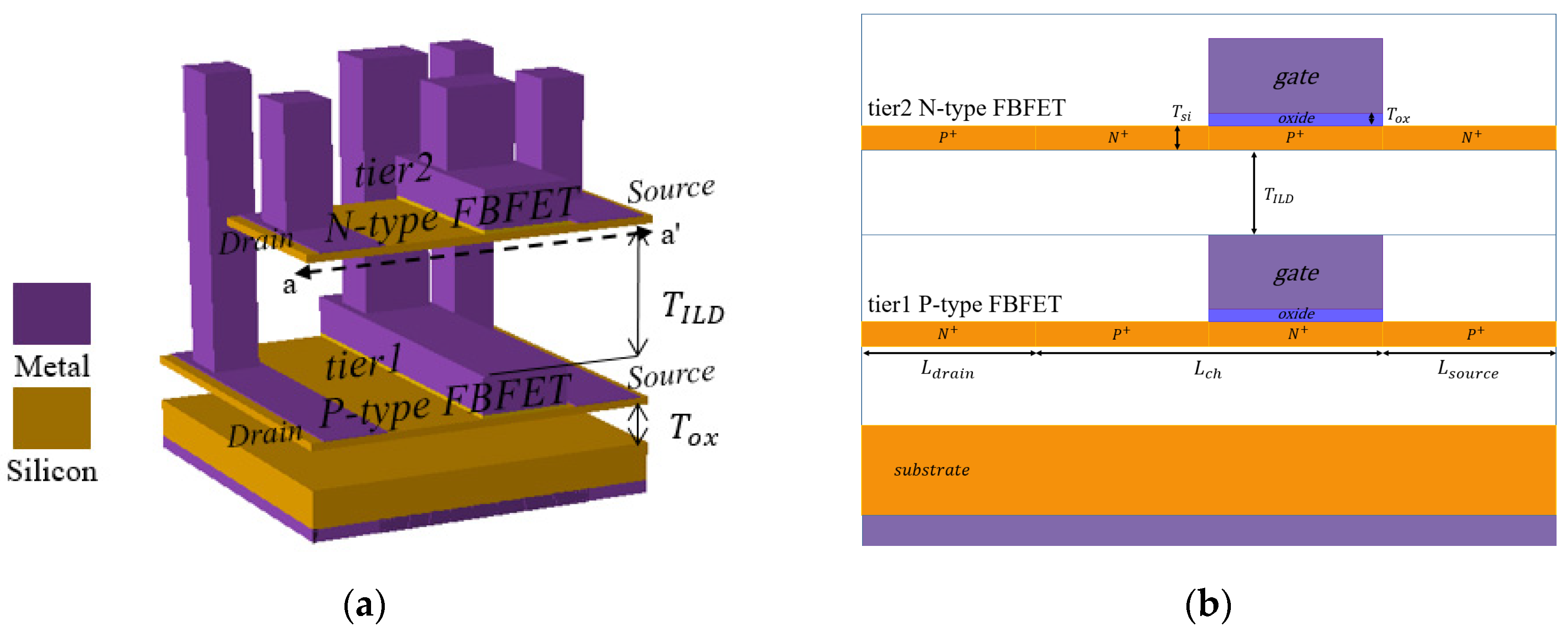
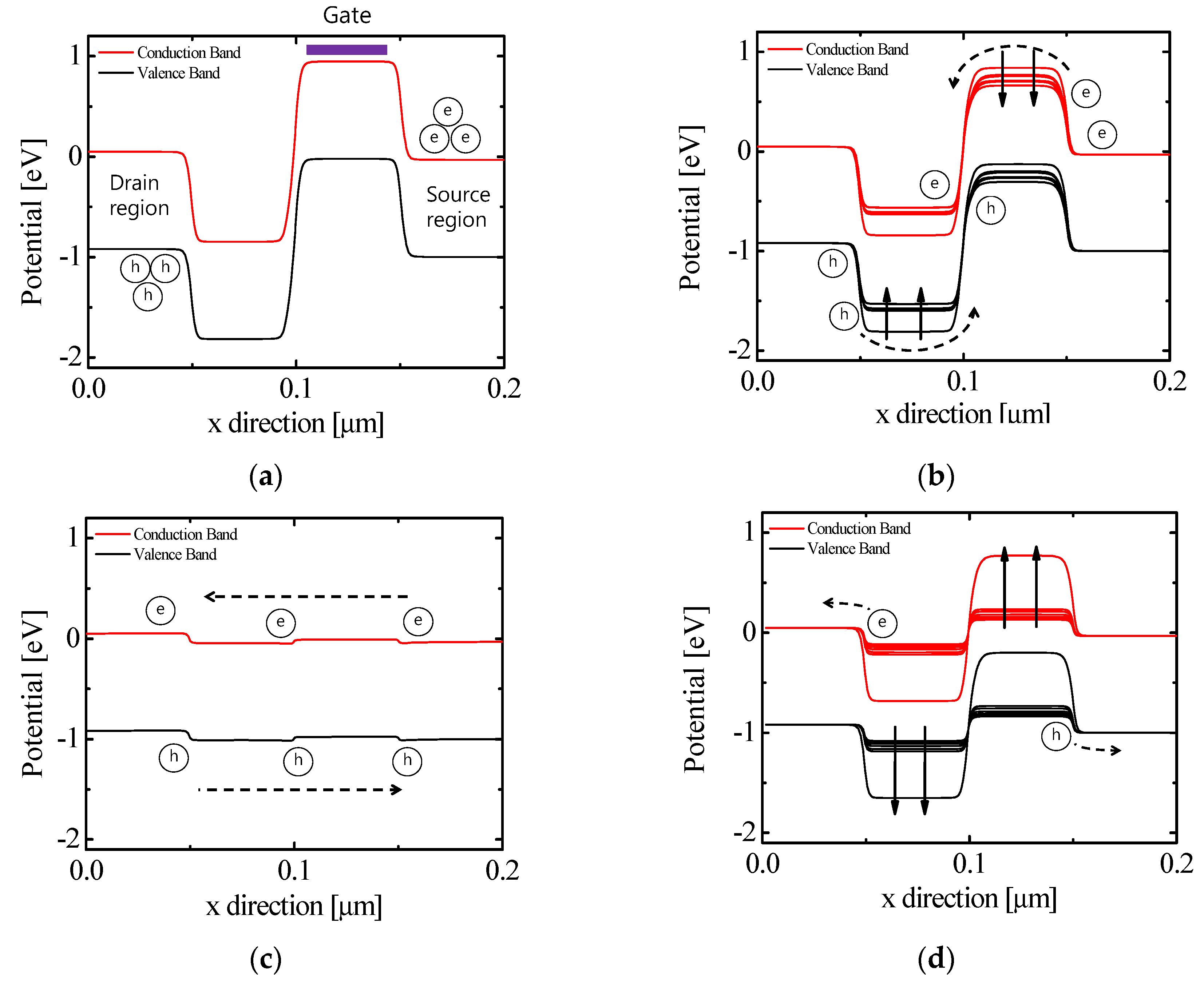
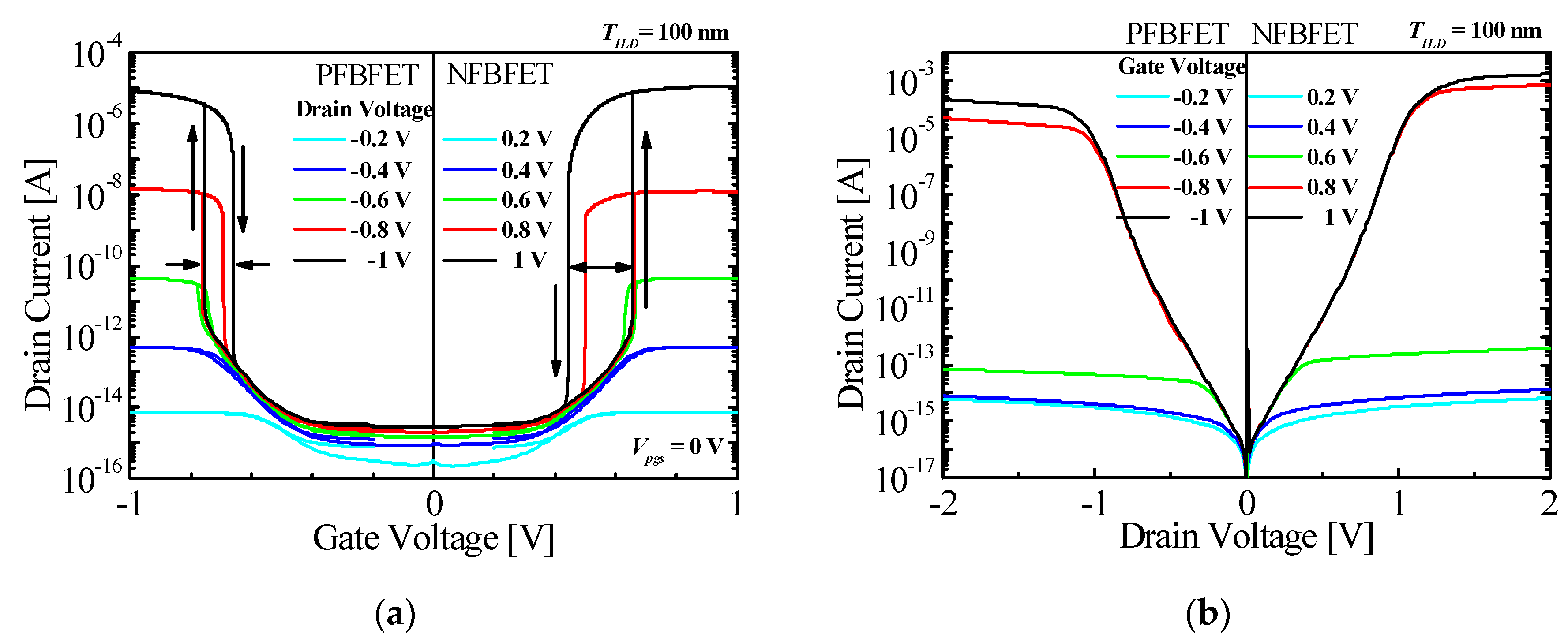
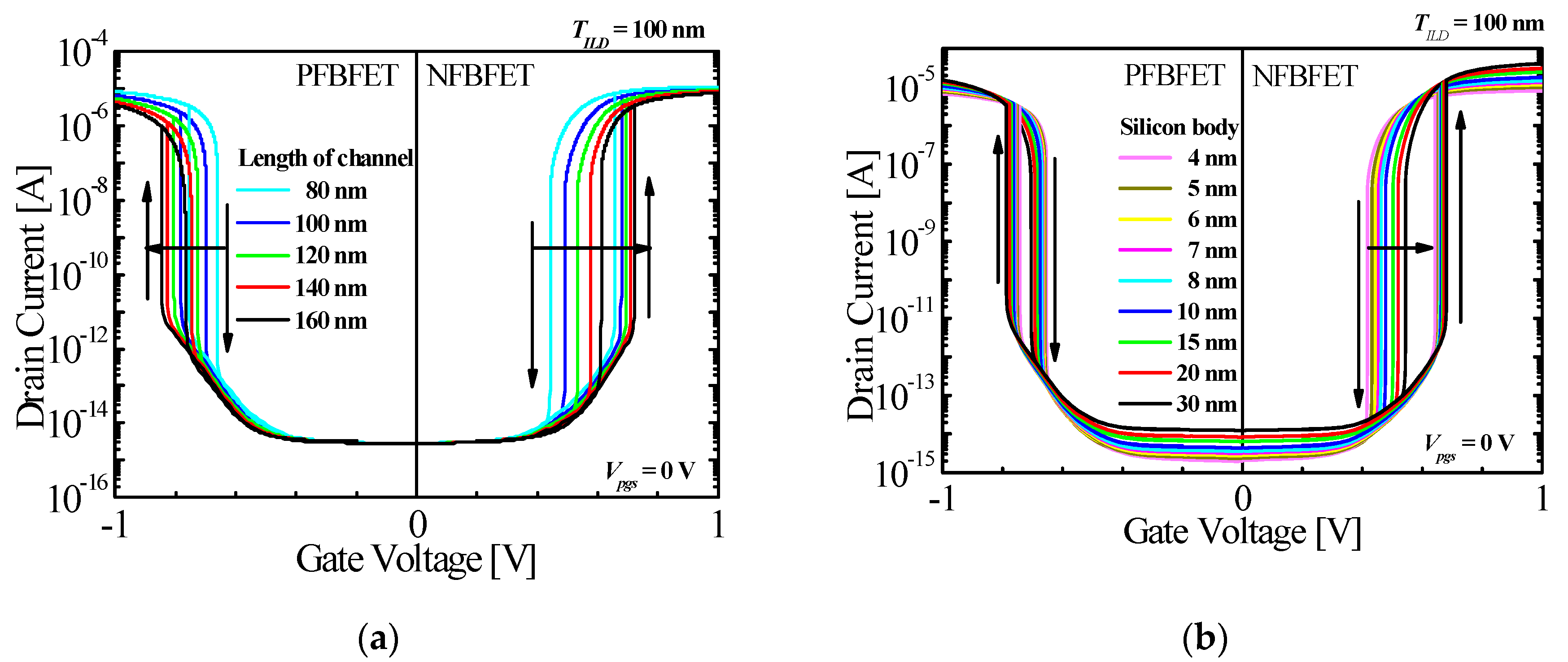
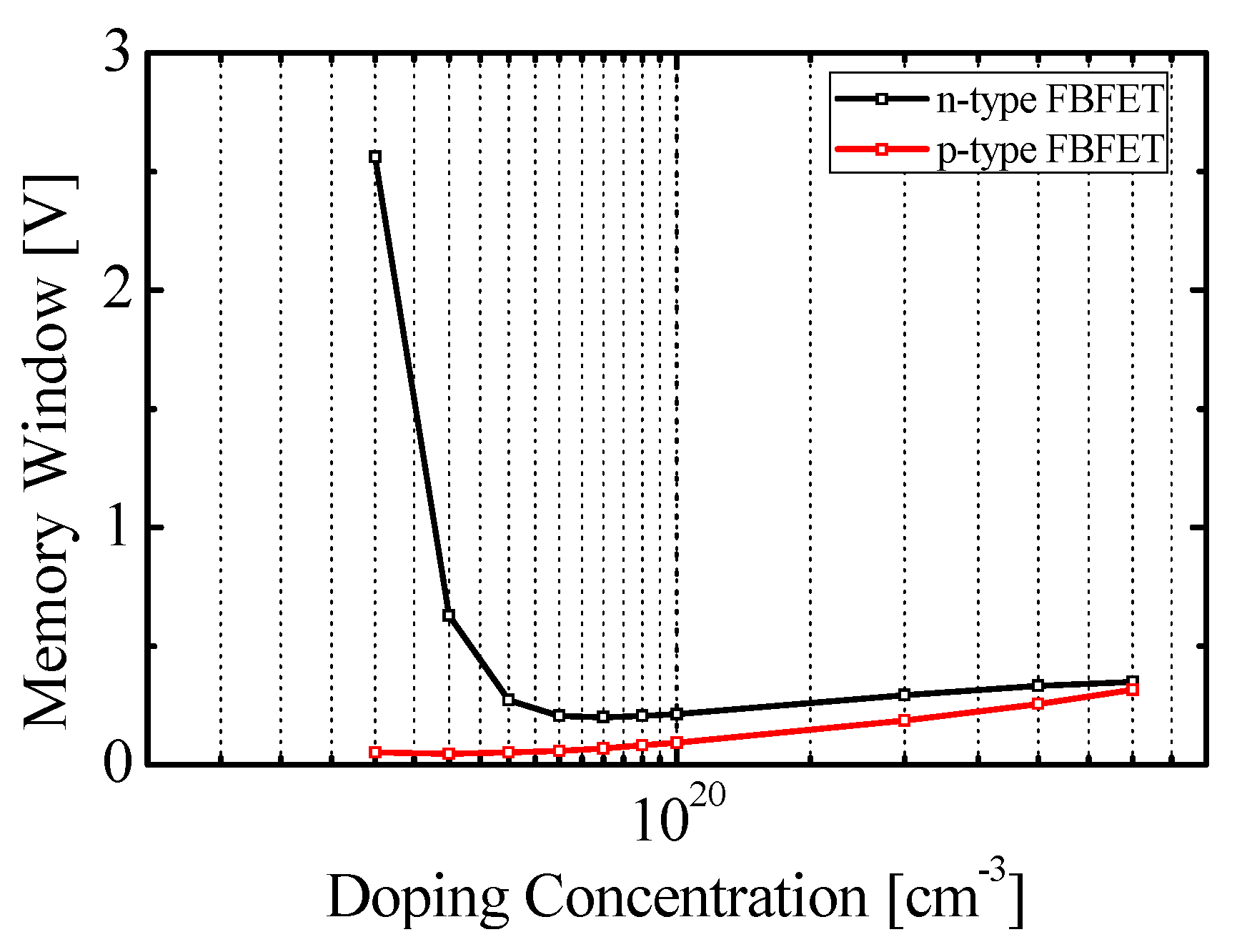
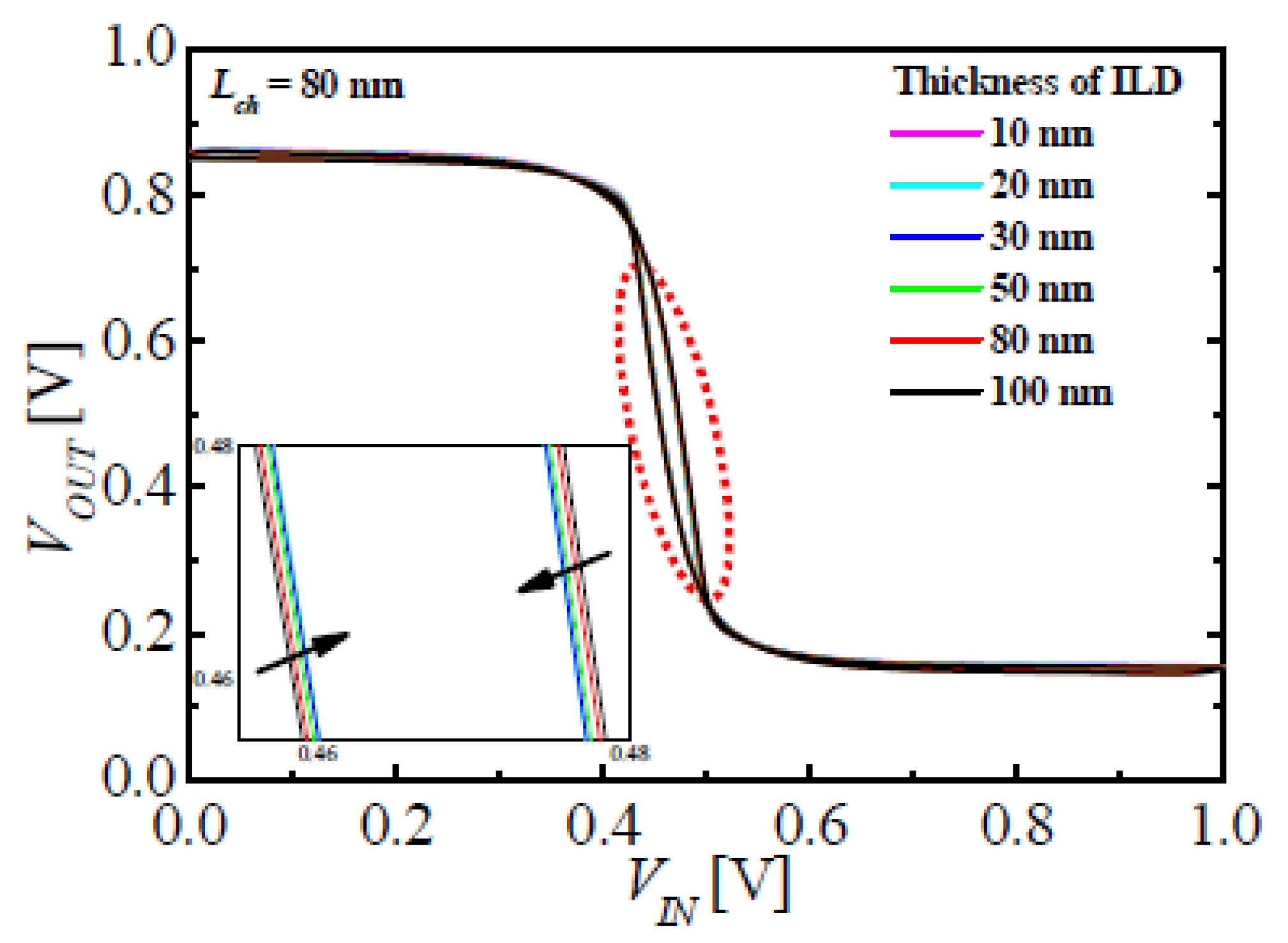
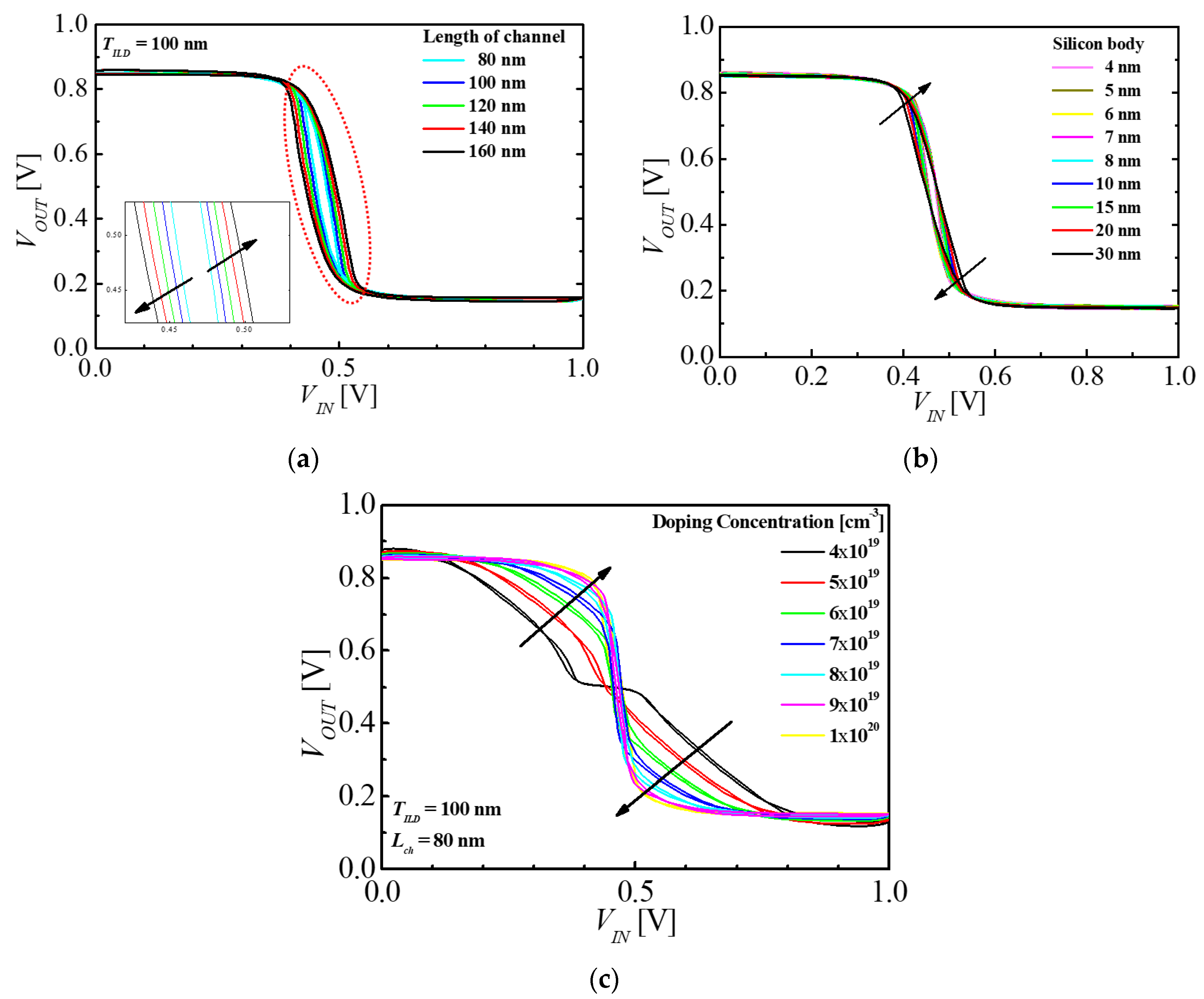
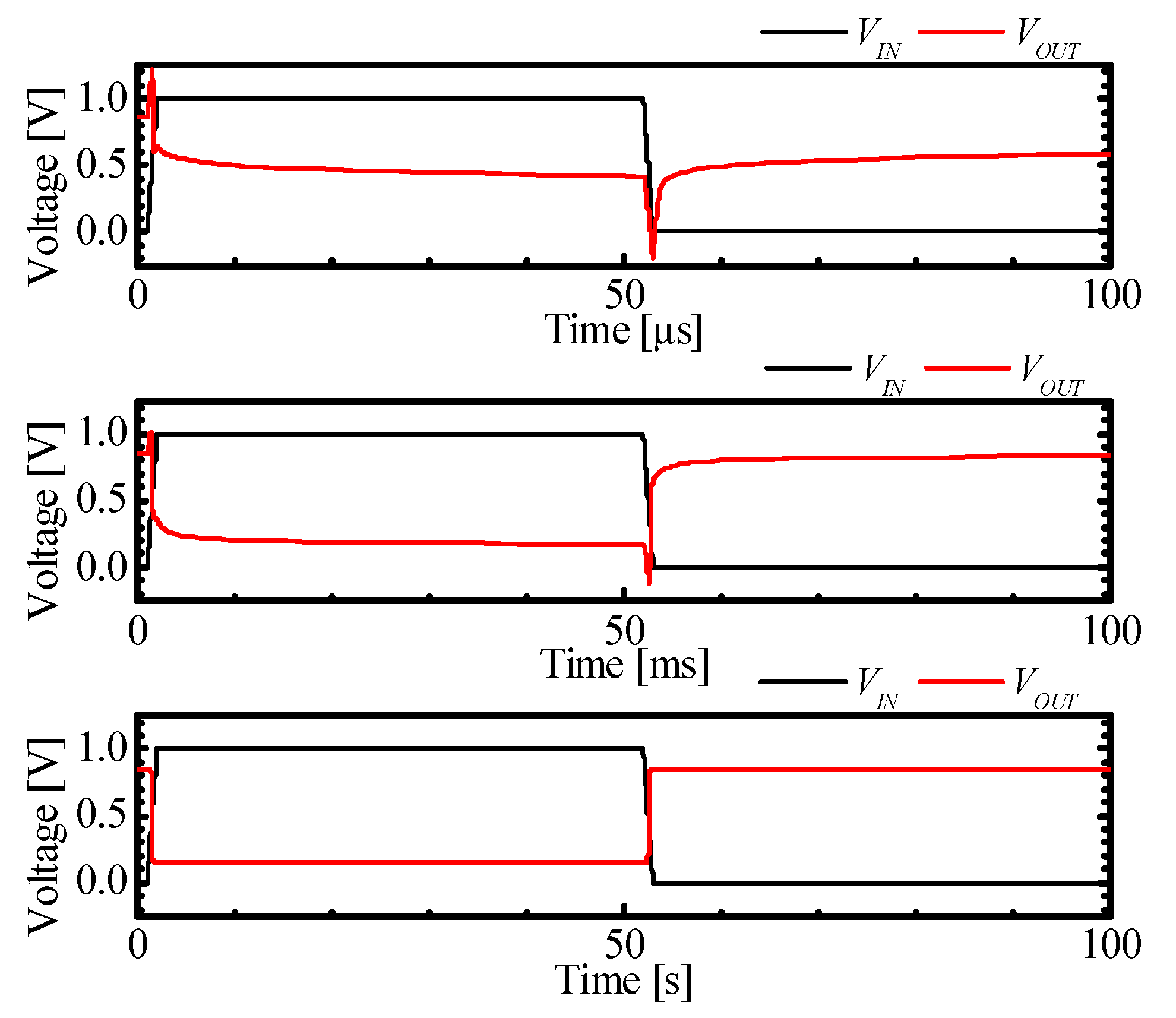
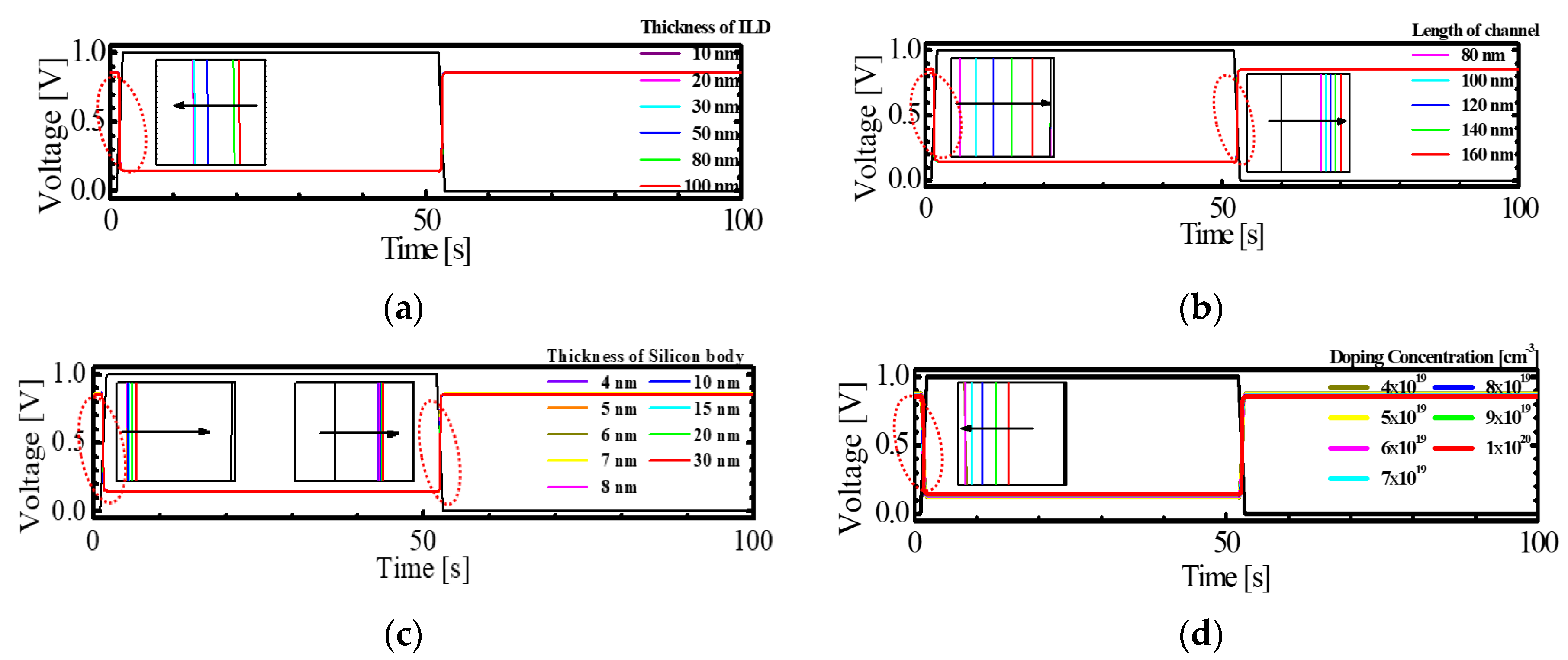
| Parameters | Description | Value/Unit |
|---|---|---|
| Ldrain | Length of drain region | 30 nm |
| Lchl | Length of channel region | 80 nm |
| Lsource | Length of source region | 30 nm |
| Tsi | Thickness of silicon body | 6 nm |
| TILD | Thickness of interlayer dielectric | 100 nm |
| Tox | Thickness of oxide | 3 nm |
| W | Width | 1 μm |
| Nch | Doping concentration of channel region below the gate | 1 × 1020 cm−3 |
| P+ region doping concentration | 1 × 1020 cm−3 | |
| N+ region doping concentration | 1 × 1020 cm−3 | |
| Substrate region doping concentration | 1 × 1015 cm−3 | |
| ΦP | Gate work function of P-type FBFET | 4.8 eV |
| ΦN | Gate work function of N-type FBFET | 4.6 eV |
© 2020 by the authors. Licensee MDPI, Basel, Switzerland. This article is an open access article distributed under the terms and conditions of the Creative Commons Attribution (CC BY) license (http://creativecommons.org/licenses/by/4.0/).
Share and Cite
Oh, J.H.; Yu, Y.S. Investigation of Monolithic 3D Integrated Circuit Inverter with Feedback Field Effect Transistors Using TCAD Simulation. Micromachines 2020, 11, 852. https://doi.org/10.3390/mi11090852
Oh JH, Yu YS. Investigation of Monolithic 3D Integrated Circuit Inverter with Feedback Field Effect Transistors Using TCAD Simulation. Micromachines. 2020; 11(9):852. https://doi.org/10.3390/mi11090852
Chicago/Turabian StyleOh, Jong Hyeok, and Yun Seop Yu. 2020. "Investigation of Monolithic 3D Integrated Circuit Inverter with Feedback Field Effect Transistors Using TCAD Simulation" Micromachines 11, no. 9: 852. https://doi.org/10.3390/mi11090852
APA StyleOh, J. H., & Yu, Y. S. (2020). Investigation of Monolithic 3D Integrated Circuit Inverter with Feedback Field Effect Transistors Using TCAD Simulation. Micromachines, 11(9), 852. https://doi.org/10.3390/mi11090852






